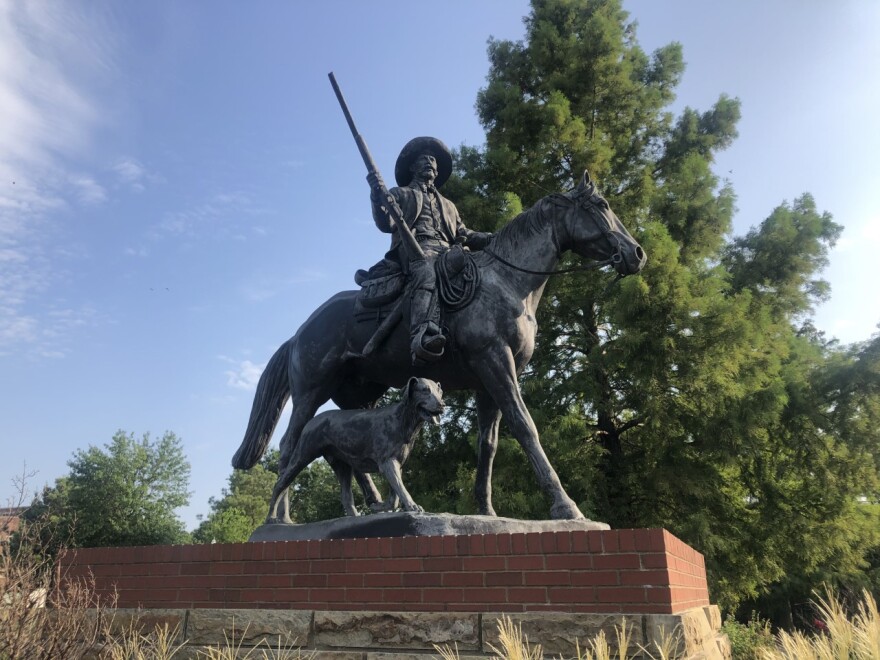One evening in July, I drove across the Oklahoma border with my father Les Howard to visit Fort Smith, Arkansas. It is a few miles away from Pocola, a small town in eastern Oklahoma where my dad grew up and still lives with my mom.
We were in Fort Smith to visit a statue of Bass Reeves, one of the first Black deputy U.S. marshals west of the Mississippi River. My dad learned about Reeves a few years ago when he saw the tall, bronze statue.

Reeves is now considered among the most prolific law enforcement officers in American history. But in recent years, people have started to also associate Reeves with being the inspiration for the character The Lone Ranger.
This is just one example of Reeves’ pop culture ties, being featured in upcoming movies like Netflix’s “The Harder They Fall,” which is a western produced by rapper Jay-Z, and acclaimed TV shows like HBO’s “Watchmen.”
The Forgotten Lawman
So to get to the bottom of whether Reeves was the real Lone Ranger, I traced the legend back to the main person responsible for popularizing it. In this case, that is Art T. Burton.
He first heard of Reeves as a child while at his grandparents’ home in Arcadia, Oklahoma. But Burton’s interest in Reeves was sparked again in the '80s when he started hearing second hand information about Reeves.
“And then he told me that Bass could outride, outshoot, outrope, outfight out-blah, blah, blah, blah,” Burton said. “And my first inclination was these people are off their rocker. Because, you know, if this guy was that good, everybody would have known about him.”
From that point forward, Burton was determined to learn everything he could about Reeves.
“So I called up the U.S. Marshal's office in Washington, D.C. And I asked them, ‘Have y'all ever heard of Bass Reeves?,’” Burton said. “And they said, ‘Yeah, we are quite aware of him. He was a real good lawman.’ I was shocked, you know. Washington, D.C.”

Burton contacted historical societies across Oklahoma and was surprised by the response.
“So I called up the Muskogee Historical Society. And a lady answered the phone, and I told her I was trying to do some research on Bass Reeves,” Burton said. “And she said, ‘I never heard of him.’ And I said, ‘Well, he was an African-American lawman that served for quite a while in the area.’ She was very polite, she says, ‘Sir, we do not keep black people's history here.’ She couldn’t see my face, but, you know, I am like, ‘Okay.’”
He came across a paper about Reeves, written by a University of Oklahoma student in the 1950s called “The Forgotten Lawman,” which became an anchor for Burton’s 30-plus years of research.
From Slave To Deputy U.S. Marshal
By most accounts, Reeves was born into slavery in Crawford County in northwest Arkansas in the 1830s. He eventually moved to Texas with his enslaver William Steele Reeves.
David Kennedy, curator of collections and exhibits at the U.S. Marshals Museum in Fort Smith, said during the Civil War, Reeves joined his enslaver’s son, an officer in a Confederate cavalry unit.
Once when the two were playing poker, Kennedy said according to folklore, the game took an interesting turn.
“The son at one point told Bass that if he won this hand, he would get his freedom,” Kennedy said. “And so they played that hand. Bass wins the hand. The son says, ‘No, you are never going to get your freedom.’ At which point Bass gets up, punches the owner's son and leaves.”
Reeves did end up gaining his freedom in the early to mid 1860s, when, by most accounts, he escaped to the Choctaw Nation.
Since Reeves knew the terrain, languages and customs of Indian Territory, he began working as a guide for U.S. deputy marshals.
Patrolling Indian Territory
The U.S. District Court for the Western District of Arkansas, which contained the office of the U.S. Marshal Service in Fort Smith, was given jurisdiction over crimes committed in Indian Territory.
“And at first, they were just looking for people who - ‘Could you ride a horse? Could you shoot a gun? Could you enforce the law?,’” Kennedy said. “But you got lucky and you got some people like Bass Reeves.”
The federal courthouse is a short trek behind the statue of Reeves in downtown Fort Smith.
The courthouse was fulfilling a need in the area.
Diron Ahlquist, an Oklahoma City-based historian for law enforcement in Indian Territory, said common crimes were murder, larceny, assault and battery, bootlegging alcohol and horse theft. One reason being that white troublemakers from surrounding states would flee to Indian Territory.
When Indian Territory was opened to non-Indigenous settlement, thousands of recently freed Black people moved there, including Reeves.
He became financially successful as he notched thousand of arrests, including his own son, who he arrested for murder.
And since Reeves was illiterate, he would memorize all of his warrants.
Was Bass Reeves The Inspiration Behind The Lone Ranger?
Art T. Burton, the foremost expert on Reeves, acknowledges he has no definitive proof that The Lone Ranger was based on Reeves, but he draws numerous parallels between the two men in his book “Black Gun, Silver Star.” But not everyone agrees.
Martin Grams, a researcher historian for vintage radio broadcasts of the 1930s and '40s, has called many of the comparisons Burton has made between Reeves and The Lone Ranger a stretch, such as both men wearing disguises and riding similar colored horses.
Another commonality Burton points out is that Reeves traveled through Indian Territory with an Indigenous posseman, similar to the character Tonto who helped guide The Lone Ranger. Grams said it was common for anyone traveling through Indian Territory to depend on an Indigenous guide.

But Grams has two pieces of evidence that seem to put this legend to rest.
One is that Grams could find no mention of Reeves in newspaper archives from the time in Detroit, where the show originated, meaning it is highly unlikely the creators of the show knew who Reeves was.
Grams also read through correspondence and telegrams between the radio show’s creators and found a day-by-day creation and formation of how “The Lone Ranger” was developed, finding no mention of Reeves.
But Grams found a letter between two of the radio program’s creators that said to make The Lone Ranger like the screen version of Tom Mix.
“And that's a smoking gun,” Grams said.
Mix appeared in hundreds of films, like the 1932 movie “My Pal, the King,” which also starred a young Mickey Rooney.
With Statehood Comes Change
Reeves was a renowned lawman, but not a flawless character.
In 1884, Reeves set up camp while on patrol in Indian Territory. Reeves supposedly got into an argument with his cook. Shortly thereafter, Reeves’ rifle allegedly went off by accident, killing his cook.
He was eventually acquitted for the killing. But the cost of his defense and lack of income left him bankrupt.
Muskogee is where Reeves spent the last years of his life, transferring there when jurisdiction changed. When Oklahoma became a state in 1907, David Kennedy from the U.S. Marshals Museum said Reeves lost his position as a U.S. deputy marshal.
“I think it was telling that you do not hear of any of the famous Black deputies of early Oklahoma statehood, whereas there were at least a couple of dozen deputies who worked out of the Western District of Arkansas during the 1800s,” Kennedy said.
Reeves died in 1910. It is unknown where he is buried, but Burton knows one thing is for certain.
“Bass is bigger than The Lone Ranger,” Burton said. “I mean, Lone Ranger was a fictional character. Bass Reeves is the real thing, and he did it for a very long time. This was a very dangerous area during the Wild West era. Bass walked into the valley of death every day for 32 years and came out. People are finding him, and I think they want to celebrate who he is.”
How Curious is a production of KGOU Public Radio. It is produced by Katelyn Howard. This episode was edited by Logan Layden. David Graey composed the theme music. If you have an Oklahoma-related question, email curious@kgou.org. Subscribe to the How Curious podcast on your favorite podcast app.
As a community-supported news organization, KGOU relies on contributions from readers and listeners to fulfill its mission of public service to Oklahoma and beyond. Donate online, or by contacting our Membership department.





